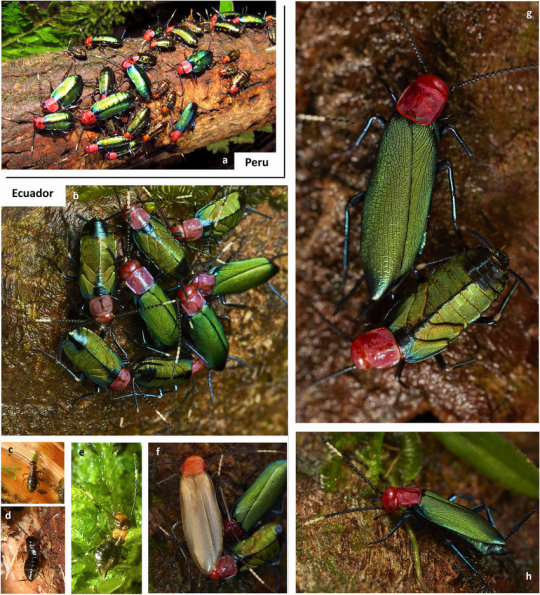#melyroidea
Text

Blister Beetle Mimic Wood Roach (Melyroidea magnifica), family Polyphagidae, Peru and Ecuador
Claims have been made by researchers that this species is eusocial (at least partially, like honeybees, many ants, and termites), however this assertion is not accepted by many entomologists. The original researchers that posited eusociality in this communal species made many dubious assumptions.
This species obviously mimics blister beetles that can blast caustic chemicals at predators. The cockroach cannot, however.
photographs from: Anton Sorokin & Adrian Tejedor
389 notes
·
View notes
Text


thinkin abt those EUSOCIAL COCKROACHES..........
(link to paper pdf)
28 notes
·
View notes
Text
Cockroach species found to live like ants with workers and a queen
Cockroach species found to live like ants with workers and a queen
[ad_1]
By Michael Marshall

A cluster of cockroaches near their nest entrance in Rio Bigal, Ecuador
Paul Bertner
Cockroaches can team up. A South American species is the first cockroach known to live in group nests, with workers and a queen – like honeybees or leaf-cutter ants.
“All cockroaches are solitary,” says Peter Vršanský at the Slovak Academy of Sciences – or so everyone…
View On WordPress
#Aclavoidea socialis#cockroach#eusocial#insect#Melyroidea ecuadoriana#Melyroidea magnifica#queen#reproduction#social#sterile#termite#worker
0 notes
Photo

BIG NEWS IN ENTOMOLOGY:
Cockroach Species Found to Live Like Ants With Workers and a Queen
“All cockroaches are solitary,” says Peter Vršanský at the Slovak Academy of Sciences in Bratislava – or so everyone thought. “It’s unbelievable!”
Neotropical Melyroidea group cockroaches reveal various degrees of (eu)sociality
Eusociality in its various degrees represents an animal social system characterised by cooperative brood care, differentiation into castes and generational overlap. The fossil record indicates that eusociality is likely to have originated in hymenopterans and blattodeans during the Cretaceous.
In this study, we present findings from surveys in Peruvian (Villa Carmen) and Ecuadorian (Rio Bigal, El Reventador) cloud forests revealing the first extant cockroach species living in complex, structured groups (n = 90-200 individuals, ˃ 20 adults).
We observed and described behaviours that suggest the existence of cooperative care, nest guarding, nest chamber preparation within hardwood Casearia sp. (Salicaceae) and bamboo (Bambusoideae), multiple overlapping generations ('different stages of' instars), colony translocation, possibly a sole reproductive female (1.25 times larger white 'queen', but no potential 'king' observed), and morphologically diversified immature stages.
In order to define the lineage where this type of sociality originated and occurs, the forms of Melyroidea magnifica Shelford, 1912, M. ecuadoriana sp. n., M. mimetica Shelford, 1912 and an undescribed species from Peru are also described in a separate section of this study.
Blattoid morphological characteristics such as typical styli suggest categorisation within distinct Oulopterygidae (Rehn, 1951), outside Corydiidae Saussure 1864. Transitional advanced sociality or semisociality in related Aclavoidea socialis gen. et sp. n. is documented in a rotting stump (n = 80 individuals, few adults).
Close phylogenetic relation between the genera, conserved morphology of numerous characters and their diverse feeding strategies generally lacking specialisation suggests a rather recent origin of a social way of life in this group. Eusociality in invertebrates and vertebrates can thus originate in various phylogenetical and ecological trajectories including predation, parasitism, care for herbs and the new one, documented through diet shift from detritivory to fungivory and algaevory.
Interdisciplinary approaches reveal the low degree of knowledge of rainforest ecosystems , with fundamental groups remaining still systematically and also behaviourally undescribed.
Read the paper here: https://www.researchgate.net/publication/344026751_Neotropical_Melyroidea_group_cockroaches_reveal_various_degrees_of_eusociality
2K notes
·
View notes